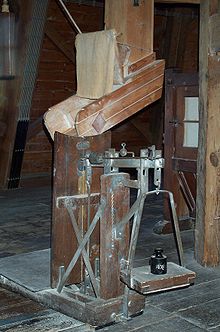Decimal scale
A decimal scale , also known as a decimal weighbridge or decimal bridge scale , is a weighing device for determining the weight of an unknown mass through direct comparison with the weight of a known mass. The unknown mass, the object to be weighed, has a ratio of 10: 1 to the known mass, the applied standard weights. In the past, sacks of flour and potatoes were often weighed with decimal scales, which is why this type of scale is also known as bag scales or potato scales .
description
With the decimal scale, heavy objects can be weighed with only a few, comparatively light weights. The decimal scale is the best known form of a weighbridge in which the weighing object is placed on a platform ("bridge"). This platform is connected to the balance beam via a rod, the so-called support lever, which is called the "upper beam" in decimal scales. Part of the load is transferred to a lower beam that lies under the platform. The lower beam is also connected to the upper beam via a second rod, the so-called intermediate lever.
The lower beam is installed in such a way that it acts as a lever arm. Part of the total weight is diverted to the floor. The support lever and intermediate lever together only transfer part of the total weight to the upper beam:
- The suspension of the support lever is very close to the pivot point of the upper beam. Therefore, the support lever only generates a small torque on the upper beam, although it transfers a relatively large amount of weight.
- The suspension of the intermediate lever is further away from the pivot point. However, the intermediate lever only transfers a small portion of the total weight, so that it also does not produce a large amount of torque.
On the other hand, according to the law of levers, a comparatively small weight is sufficient to compensate for the torque. The decimal scale is designed in such a way that ten times the weight is weighed with the standard weights placed on it. With larger weight loads, this means a decisive improvement over the straight- arm scales .
history
The decimal scales used in German-speaking countries go back to the Benedictine monk Friedrich Alois Quintenz (* 1774 in Gengenbach ; † 1822 in Strasbourg ). Quintenz improved the decimal weighbridge designed by the watchmaker Jean-Baptiste Schwilgué by moving the bridge that was still on top of the Schwilgué decimal weigher down. With the fifth decimal scale, registered for a patent in Strasbourg in 1821, determining the weight of comparatively large masses was made much easier, because now the heavy goods no longer had to be lifted too high.
Individual evidence
- ↑ Information on the decimal scale lehrerfreund.de (see sketch)
- ↑ How does a decimal scale work? themt.de (with calculation example)
- ↑ Reuleaux: Textbook of Kinematics - The practical relationships of kinematics to geometry and mechanics, 1875 (PDF file; 13.16 MB), see p. 320.

